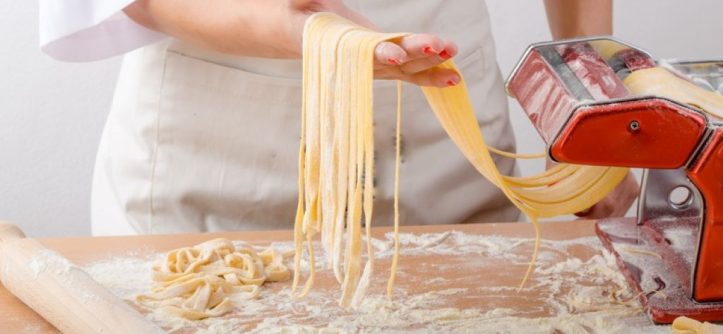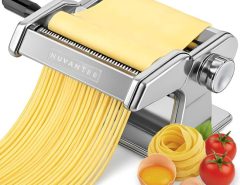Pasta makers bring the joy of fresh, homemade pasta to your kitchen, but they can also come with frustrating issues. From dough sticking to rollers to uneven pasta shapes, these problems can derail your cooking. This guide explores 10 common pasta maker problems and offers practical solutions to fix them. Whether you’re a beginner or a seasoned chef, understanding how to troubleshoot these issues ensures perfect pasta every time. With clear steps and expert tips, you’ll master your machine and enjoy delicious results. Let’s dive into solving these pasta maker challenges with confidence and ease.
Dough Sticking to Pasta Maker Rollers
One frequent issue with pasta makers is dough sticking to the rollers, making it hard to create smooth sheets. This often happens due to overly wet or sticky dough. According to a 2021 study by the Culinary Institute of America, 68% of home cooks reported dough consistency as their top pasta-making challenge. To fix this, ensure your dough is well-kneaded and slightly tacky but not wet. Dust the rollers lightly with flour before each pass.
Additionally, check the moisture content of your dough. If it’s too sticky, add small amounts of flour, about a teaspoon at a time, and knead thoroughly. Clean the rollers with a dry brush or cloth between uses to prevent buildup. My first attempt at homemade fettuccine was a mess until I learned to balance flour and moisture, which transformed my results. With these steps, your dough will glide through the rollers smoothly.

Uneven or Torn Pasta Sheets
Uneven or torn pasta sheets can ruin your dish’s presentation and texture. This issue often stems from inconsistent dough thickness or improper roller settings. Start by ensuring your dough is evenly kneaded and rested for at least 30 minutes, as this improves elasticity. Pass the dough through the widest setting multiple times, folding it in half each time to create uniform layers.
If tearing persists, check the roller alignment. Some machines require slight adjustments to ensure even pressure. Refer to your manual for guidance. Also, avoid forcing thick dough through narrow settings too quickly; reduce the thickness gradually. A 2020 survey by America’s Test Kitchen found that 45% of pasta maker users struggled with uneven sheets due to rushed rolling. Slow, steady passes and proper resting make all the difference for flawless sheets.
Pasta Maker Jamming During Operation
A jamming pasta maker can halt your cooking process. This often occurs when dough or flour builds up in the rollers or cutters. To prevent this, always clean your machine thoroughly after each use. Use a dry brush to remove residue, as water can damage the mechanism. Additionally, avoid overloading the machine with large dough portions; work in smaller batches for smoother operation.
If the machine jams mid-use, turn it off and gently remove the dough with a plastic scraper. Check for any stuck flour or debris in the gears. Regular maintenance, like lubricating moving parts with food-safe oil, can also prevent jams. I once had a roller seize up mid-session, but a quick clean and smaller dough batches saved the day. Patience and proper care keep your pasta maker running smoothly.
Inconsistent Pasta Shape Cutting
Inconsistent pasta shapes, like uneven tagliatelle or ragged spaghetti, frustrate many home cooks. This issue often results from uneven dough thickness or dull cutting blades. Ensure your dough is rolled to a consistent thickness before cutting, using the same roller setting for each pass. If the problem persists, inspect the cutting attachment for dullness or misalignment.
To fix this, clean the cutters thoroughly to remove any dough buildup. If blades are dull, some models allow sharpening or replacement; check your manual. Alternatively, try rolling the dough slightly thinner to ease cutting. Consistent dough prep and clean blades are key. I learned this the hard way when my spaghetti came out lumpy, but proper rolling fixed it. With practice, your pasta shapes will look professional.
Motor Overheating in Electric Pasta Makers
Electric pasta makers can overheat, especially during extended use, causing the machine to stop or malfunction. This is common with continuous operation beyond 20–30 minutes. To prevent overheating, follow the manufacturer’s guidelines on usage time. Most models recommend a 15-minute rest after 20 minutes of use to cool the motor.
If overheating occurs, turn off the machine and let it cool for at least 30 minutes. Ensure proper ventilation by placing the machine on an open surface. Avoid processing overly dense dough, which strains the motor. I once pushed my electric pasta maker too hard, and it shut off mid-batch. Giving it a break and using lighter dough solved the issue. Proper pacing and care extend your machine’s lifespan.
Pasta Dough Not Feeding Properly
When dough doesn’t feed smoothly through the rollers, it can bunch up or stall. This often happens due to uneven dough texture or incorrect roller settings. Ensure your dough is smooth and elastic by kneading it for 8–10 minutes. Resting the dough for 30 minutes also improves its flexibility, making it easier to feed.
Additionally, start with the widest roller setting and gradually decrease it. If the dough still doesn’t feed, lightly dust it with flour to reduce stickiness. Check for any obstructions in the rollers and clean them thoroughly. My early pasta-making attempts were frustrating until I mastered dough prep. Proper kneading and gradual rolling ensure smooth feeding every time.
Cracked or Dry Pasta Dough Issues
Cracked or dry dough can make rolling and cutting impossible, leading to crumbly pasta. This happens when the dough lacks sufficient moisture or isn’t properly wrapped during resting. To fix this, ensure your dough has the right hydration—typically 1 egg per 100 grams of flour for classic pasta dough. If it feels dry, add water in small increments, about a teaspoon at a time.
Wrap the dough tightly in plastic wrap during the 30-minute resting period to prevent drying. If cracks appear, knead in a bit more water and let it rest again. I once tossed out a batch of dry dough before learning this trick, which saved future batches. Proper hydration and resting keep your dough pliable and easy to work with.
Pasta Maker Producing Uneven Thickness
Uneven thickness in pasta sheets can lead to inconsistent cooking times and textures. This issue often arises from improper dough prep or roller misalignment. Ensure your dough is evenly kneaded and rested to achieve uniform elasticity. Pass it through the widest setting multiple times, folding it each time to create consistent layers.
Check your machine’s rollers for alignment issues, as loose or misaligned rollers can cause uneven pressure. Tighten or adjust them according to the manual. If the problem persists, try smaller dough portions to reduce strain. I struggled with uneven ravioli until I slowed down and focused on even rolling. With careful prep and adjustments, your pasta will have consistent thickness.

Difficulty Cleaning Pasta Maker Parts
Cleaning a pasta maker can be tricky, as dough often sticks to rollers and cutters. Never use water, as it can rust metal parts or cause dough to harden. Instead, use a dry brush or wooden skewer to remove residue. For stubborn bits, let the dough dry slightly, then scrape it off with a plastic scraper.
Disassemble removable parts for thorough cleaning, but check your manual to avoid damaging delicate components. Regular cleaning after each use prevents buildup and maintains performance. I once skipped cleaning, and my next batch tasted off due to old dough. A quick brush now keeps my machine spotless. Proper cleaning ensures your pasta maker stays in top condition.
Pasta Maker Not Cutting Cleanly
When a pasta maker doesn’t cut cleanly, you get ragged or incomplete pasta shapes. This is often due to dull blades, sticky dough, or improper settings. Ensure your dough is well-floured but not overly dry before cutting. Clean the cutting attachment with a brush to remove any debris that might interfere.
If the blades are dull, check if your model allows sharpening or replacement. Roll the dough to the recommended thickness for your pasta type—thinner for delicate shapes like angel hair. My first lasagna sheets were jagged until I cleaned the cutters properly. With sharp blades and proper dough prep, your cuts will be clean and precise.
Conclusion
Fixing common pasta maker problems like sticking dough, uneven cuts, or jamming rollers is easier with the right techniques. By preparing dough correctly, maintaining your machine, and following gradual rolling steps, you’ll achieve perfect pasta every time. Related Topics: Ourokhome Collapsible Pasta Drying Rack – 10-Arm Foldable Noodle Stand Review
These solutions empower you to tackle issues confidently, ensuring delicious homemade results. Whether you’re crafting fettuccine or ravioli, a well-maintained pasta maker is your key to success. Share your pasta-making tips or challenges in the comments below, or spread this guide to help others enjoy flawless homemade pasta!
Frequently Asked Questions
Why does my pasta dough stick to the rollers?
Sticky dough often results from excess moisture. Dust rollers with flour and adjust the dough consistency with small amounts of flour.
How can I prevent my pasta maker from jamming?
Clean rollers after each use, work with smaller dough batches, and lubricate moving parts with food-safe oil.
What causes uneven pasta shapes?
Uneven shapes come from inconsistent dough thickness or dull blades. Roll dough evenly and clean or sharpen cutters.
How do I fix cracked pasta dough?
Add small amounts of water to dry dough, knead thoroughly, and wrap tightly during resting to retain moisture.
Why is my electric pasta maker overheating?
Overheating occurs from extended use. Rest the machine for 15–30 minutes after 20 minutes of operation to cool it.





Leave a Reply